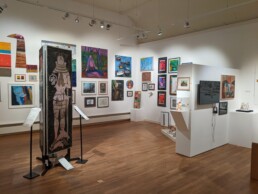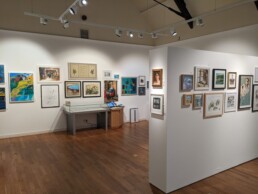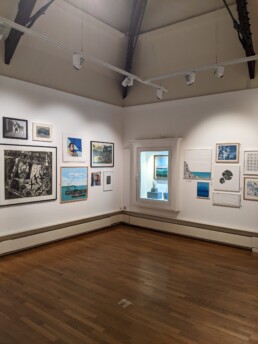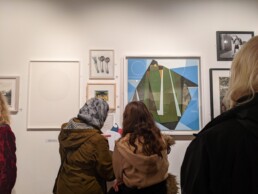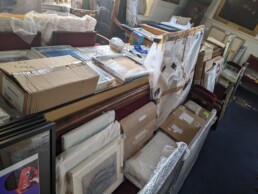IMAGINE FALMOUTH
CURATED BY EMILY SPARGO AT FALMOUTH ART GALLERY
‘Imagine Falmouth’ showcases artworks by emerging and established artists in the Cornwall area. It epitomises the gallery’s core values of community and creativity, and each show marks a more ambitious hang. There is no theme or medium regulation, and the only ask is that the works be made in the last year and submitted by the artist who made them. A panel of judges review submissions to pick a selection to go on show to the public. Prizes are awarded to the judges’ favourite, highly commended, public choice, and best under 18s. Artists also have the option to list their work for sale to the public.
CURATORIAL TASK: REFLECTIVE WRITING
Going Digital: Reflections on ‘Imagine Falmouth’ and its new digital process
In the final months of our internship, myself and the other Trainees were tasked with leading on a project within our museums. Providing the opportunity to sharpen skills learnt through our work placements and various curatorial tasks, the project was something for us to take ownership of and pursue specific areas of interest. Choosing what to do was in itself difficult but I am grateful I had the freedom of choice and to Falmouth Art Gallery for their support and flexibility.
My chosen project was to ‘re-Imagine Falmouth’. The ‘Imagine Falmouth’ show is the gallery’s bi-annual open exhibition and art prize highlighting emerging and established artists. There is no age, theme or medium specifications, the gallery only asks that the works be made in the previous two years by anyone living in Cornwall. All works that go on display are reviewed and selected from the hundreds submitted by a committee of Falmouth and Penryn-based arts professionals. A small panel of judges select prize winners in the competition categories and there is also a public choice prize announced once the show has finished.
Having been delayed one year due to the pandemic and with visitor numbers not back to pre-covid levels, I proposed to review and develop the exhibition to support its continued enjoyment for the public and gallery staff. It seemed there was room for development in aspects of the logistics: the submission process, choosing the selection committee, the selection process, its curatorial method, the public vote and the distribution of prize money. The overall ambition was to improve the standard of practice by mostly digital and online means – the use of which continued to be crucial post-lockdown – prioritising accessibility, audience engagement, and community benefit.
In review of the 2019 show, Anne Saddler said: ‘Imagine Falmouth is a visual example of inclusivity and equality. Artists coming together to celebrate their creativity: unified in the love of their art.’ The 2022 exhibition would mark the third instalment, so even in its relatively young existence, it was apparently valued by many artists and members of the public. For staff, it encapsulates the gallery’s principles of creativity, community and collaboration by producing the opportunity for locals to see their artwork on the walls of their public gallery and to be involved in the selection process. These reasons motivated me to question: how can this be more inclusive, accessible, and community focused so that it can be enjoyed by as many people as possible?
The project’s core aim was to bring much of the process online with a dedicated website, submission portal, pages to exhibit artworks, and a voting platform for the selection committee. There was a burgeoning need to reduce the administrative burden that comes with the overly complex nature of this exhibition. In previous years, artists were invited to submit using a PDF application form – receiving hundreds of applications increasing with each show created an awkward and tiresome process for staff – so with submissions moved to a safe online storage system, the access, retrieval and display of information would be eased considerably. Many lengthy meetings were had between myself and Oliver, the gallery’s Digital Officer, who made all my ideas come to life even better than I could have imagined. We ended up with a simple ‘off-the-shelf’ WordPress site and entry form plug-in costing under one hundred pounds; a free Coda account (a fantastic website that uses simple HTML formulas to display data); and an iPad for public voting, already owned by the gallery.
One of the fantastic things about Coda is that it did all the hard work for us. After converting the submissions into a CSV file, we could transfer and display the data from our entries in Coda in ways suited to certain needs at different stages of the project. For example, during the planning of the physical exhibition we were able to view the final selection of artworks including the total measurements of gallery wall space required; for the selection process, we were able to display every individual artwork with a voting card in a password protected account for each judge to make their votes in a remote, secure and saveable location; we were also able to produce the catalogue of exhibited artworks in a reader and printer friendly list without needing to change Coda’s design or using Excel.
Overall, we were thrilled to make a system that was straightforward, effective and replicable. I was particularly amazed at how strategic and creative we could be using free online platforms. The new process gave the exhibition a refreshed presence and attracted new audiences so we were pleased to achieve our initial objectives to a happy extent (there’s room to improve for next time!). I hope it will continue to serve future editions of the show and be an enjoyable tool for the community. The ‘cherry-on-top’ moment was when Jasmine Blackmoore’s video artwork ‘‘Mycelium Song’ was voted the Prize winner by our independent panel of judges – an apt moment of celebration for digital.
The next Imagine Falmouth exhibition will be in 2024.
